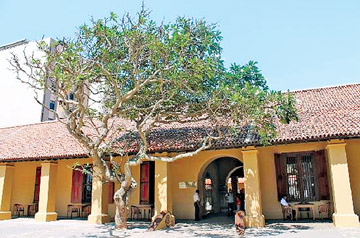Safeguarding ancient ruins, a sine qua non
By Amal Hewavissenti
 |
| Renovated
Mirisawetiya Chaitiya |
We, Sri Lankans are always governed by immense pride of having an
archaeological legacy which dates back, perhaps to the farthest point in
history of the country. It is however, the bounden duty of our younger
generation to protect this unique cultural heritage and thereby transfer
it to the future world without altering its identity and vitality.
The terms "archaeological remains" simply refer to the Buddhist,
Hindu, Christian or Islamic statues, monuments, dagabas, paintings,
pottery and other architectural masterpieces that roughly belong to the
period prior to 1815. At the same time, inscriptions, coins and pottery
fragments are archaeological remains which disguise a golden age in the
past.
Even the Dutch Fort of Galle that is over hundreds years old, falls
into this category. The artefacts and the archaeological monuments are,
in fact, the physical remains of the unrivalled masterpieces and the
lifestyle of ancient people that help re-establish history.
There is yet another definition for the words "archaeological
remains". It says that movable or immovable property that is hundred
years old is an archaeological monument to be protected.
Yet an interesting question arises as to why these archaeological
monuments are to be protected. Research based on the remains have
uncovered interesting life styles, relationships principles, economy and
politics of the people of the ancient world.
|

Galle Dutch Fort |
The present generation should shoulder the responsibility of passing
this valuable objects and knowledge on to the future generations. Though
the Dutch were invaders to Sri Lanka, their coastal fortresses and
objects used by them are now being safeguarded as priceless
archaeological evidence of their invasion.
Thus the historic places and monuments belonging to various religious
communities are being preserved as national heritage irrespective of any
distinctions.
Sri Lanka too is blessed with a surprising array of archaeological
monuments and artefacts that can come on par with world's best
archaeological masterpieces. The irrigation technology which evolved
through centuries and the masterly art evolving deep taste and aesthetic
feelings make international visitors marvel at the top level Sri Lanka
had reached in the past.
In the third century BC, Sri Lanka's national identity was nourished
by Arhat Mahinda's mission and the advent of Buddhism. Here, the ancient
kings had a well-mounted mechanism to preserve the cultural heritage
bestowed by their predecessors. The kings themselves set a good example
of protecting archaeological wonders for future generations by launching
frequent renovations on deteriorating buildings, dagabas and other
important structures.
|

Refurbished Dutch Hospital at Echelon Square, Colombo Fort |
They launched massive developmental programs to upgrade the national
heritage and gave full patronage to the building of more monuments that
show themselves in the form of ruins today. The unbreakable link between
Buddhism and the State gave boundless protection for the rare
archaeological remains.
Ancient rulers were extremely careful to lavish State patronage for
renovation of archaeological monuments erected by earlier rulers.
King Nissankamalla had renovated a number of monuments and appointed
a team of officials to superintend the restoration work. The record on
his restoration of monuments such as 'Mirisawetiya' is a clear statement
that he willingly continued the great work of restoration by King
Parakramabahu the Great.
History speaks volumes for multiple cases in which rulers displayed
their commitment to restore the buildings, statues, or paintings to its
pristine grandeur. Mahavamsa, for instance, explicitly states how "Lowa
Maha Paya" was restored and modified by successive rulers.
Historical chronicles stress that the rulers most often supervised
the maintenance of such heritage sites providing funds collected in the
form of tax levied on people.
Historical evidence shows that King Parakramabahu the Great had
appointed a special minister to supervise the restoration of heritage
structures that were running into a state of disrepair and ruin. In the
year 1990, the Archaeological Department laid a sound foundation towards
protecting heritage sites for future generations by registering some
11,185 heritage sites scattered in the country.
It is highly important to launch propaganda on archaeological finds
from excavations and take them to the common people creating an
atmosphere in which they realise the real value of monuments and objects
uncovered.
It is totally necessary that new awareness programs on national
heritage sites so far registered are mapped out.
We can also create a powerful tourist attraction to those heritage
sites. Experts on archaeology suggest that the authorities can focus on
building mini-museums in which excavated remains can be displayed to the
public.
We are adequately equipped to make successful arrangements to attract
tourists and schoolchildren to the national museum and the provincial
museums.
It is important to make public awareness programs on steps to be
taken to curb the activities of treasure hunters and those who destroy
archaeological remains.
There is a popular suggestion to combine higher education
institutions with archaeological sites.
For example, universities and schools that are in close proximity to
archaeological sites can organise cleaning campaigns and other projects
that help to maintain them. |


